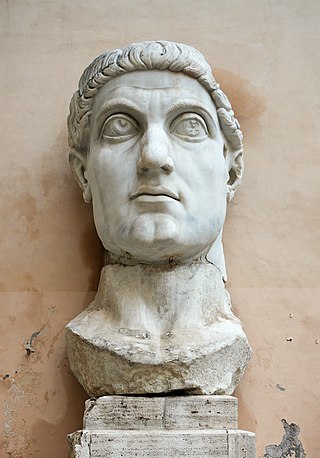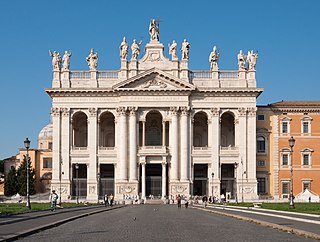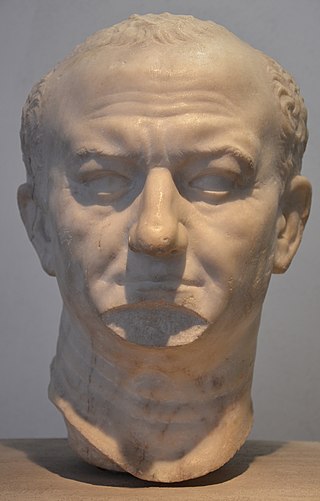
Flavius Julius Constans, sometimes called Constans I, was Roman emperor from 337 to 350. He held the imperial rank of caesar from 333, and was the youngest son of Constantine the Great.

Constantine II was Roman emperor from 337 to 340. Son of Constantine the Great and co-emperor alongside his brothers, his attempt to exert his perceived rights of primogeniture led to his death in a failed invasion of Italy in 340.

Constantine I, also known as Constantine the Great, was Roman emperor from AD 306 to 337. He was the first emperor to convert to Christianity. Born in Naissus, Dacia Mediterranea, he was the son of Flavius Constantius, a Roman army officer of Illyrian origin who had been one of the four rulers of the Tetrarchy. His mother, Helena, was a Greek woman of low birth and a Christian. Later canonized as a saint, she is traditionally attributed with the conversion of her son. Constantine served with distinction under the Roman emperors Diocletian and Galerius. He began his career by campaigning in the eastern provinces before being recalled in the west to fight alongside his father in the province of Britannia. After his father's death in 306, Constantine was acclaimed as imperator by his army at Eboracum. He eventually emerged victorious in the civil wars against emperors Maxentius and Licinius to become the sole ruler of the Roman Empire by 324.

The 40s decade ran from January 1, AD 40, to December 31, AD 49.
The 310s decade ran from January 1, 310, to December 31, 319.
The 320s decade ran from January 1, 320, to December 31, 329.

Year 313 (CCCXIII) was a common year starting on Thursday of the Julian calendar. At the time, it was known as the Year of the Consulship of Constantinus and Licinianus. The denomination 313 for this year has been used since the early medieval period, when the Anno Domini calendar era became the prevalent method in Europe for naming years. This year is notable for ending of the persecution of Christians in the Roman Empire.
The 330s decade ran from January 1, 330, to December 31, 339.

Year 320 (CCCXX) was a leap year starting on Friday of the Julian calendar. At the time, it was known as the Year of the Consulship of Constantinus and Constantinus. The denomination 320 for this year has been used since the early medieval period, when the Anno Domini calendar era became the prevalent method in Europe for naming years.

Year 315 (CCCXV) was a common year starting on Saturday of the Julian calendar. At the time, it was known as the Year of the Consulship of Constantinus and Licinianus. The denomination 315 for this year has been used since the early medieval period, when the Anno Domini calendar era became the prevalent method in Europe for naming years.

Flavia Julia Helena Augusta was an Augusta of the Roman Empire and mother of Emperor Constantine the Great. She was born in the lower classes traditionally in the Greek city of Drepanon, Bithynia, in Asia Minor, which was renamed Helenopolis in her honor, though several locations have been proposed for her birthplace and origin.

The Archbasilica Cathedral of the Most Holy Savior and of Saints John the Baptist and John the Evangelist in the Lateran, also known as the Papal Archbasilica of Saint John [in] Lateran, Saint John Lateran, or the Lateran Basilica, is the Catholic cathedral church of the Diocese of Rome in the city of Rome, and serves as the seat of the bishop of Rome, the pope. The archbasilica lies outside of Vatican City proper, which is located approximately 4 kilometres (2.5 mi) to the northwest. Nevertheless, as properties of the Holy See, the archbasilica and its adjoining edifices enjoy an extraterritorial status from Italy, pursuant to the terms of the Lateran Treaty of 1929. Laterano (Lateran) comes from an ancient Roman family (gens), whose palace (domus) grounds occupied the site; the Lateran Palace was the primary residence of the pope until the Middle Ages.

Flavius Julius Crispus was the eldest son of the Roman emperor Constantine I, as well as his junior colleague (caesar) from March 317 until his execution by his father in 326. The grandson of the augustus Constantius I, Crispus was the elder half-brother of the future augustus Constantine II and became co-caesar with him and with his cousin Licinius II at Serdica, part of the settlement ending the Cibalensean War between Constantine and his father's rival Licinius I. Crispus ruled from Augusta Treverorum (Trier) in Roman Gaul between 318 and 323 and defeated the navy of Licinius I at the Battle of the Hellespont in 324, which with the land Battle of Chrysopolis won by Constantine forced the resignation of Licinius and his son, leaving Constantine the sole augustus and the Constantinian dynasty in control of the entire empire. It is unclear what was legal status of the relationship Crispus's mother Minervina had with Constantine; Crispus may have been an illegitimate son.
This is an alphabetical index of people, places, things, and concepts related to or originating from the Byzantine Empire. Feel free to add more, and create missing pages. You can track changes to the articles included in this list from here.

Flavia Maxima Fausta Augusta was a Roman empress. She was the daughter of Maximian and second wife of Constantine the Great, who had her executed and excluded from all official accounts for unknown reasons. Historians Zosimus and Zonaras reported that she was executed for adultery with her stepson, Crispus.

In the Christian liturgical calendar, there are several different Feasts of the Cross, all of which commemorate the cross used in the crucifixion of Jesus. Unlike Good Friday, which is dedicated to the passion of Christ and the crucifixion, these feast days celebrate the cross itself, as the sign of salvation. In Western Catholicism, Eastern Catholicism, Eastern Orthodoxy, Oriental Orthodoxy, Lutheranism and Anglicanism the most common day of commemoration is 14 September, or 27 September in churches still using the Julian calendar.

The gens Flavia was a plebeian family at ancient Rome. Its members are first mentioned during the last three centuries of the Republic. The first of the Flavii to achieve prominence was Marcus Flavius, tribune of the plebs in 327 and 323 BC; however, no Flavius attained the consulship until Gaius Flavius Fimbria in 104 BC. The gens became illustrious during the first century AD, when the family of the Flavii Sabini claimed the imperial dignity.

Priestess of Avalon is a 2000 novel by American writer Marion Zimmer Bradley, completed posthumously by Diana L. Paxson. It follows detailing the life of Helena, first wife of Western Roman Emperor Constantius Chlorus and mother of Constantine.
Flavia Valeria Constantina, later known as Saint Constance, was the eldest daughter of Roman emperor Constantine the Great and his second wife Fausta, daughter of Emperor Maximian. Constantina may have received the title of Augusta by her father, and is venerated as a saint, having developed a medieval legend wildly at variance with what is known of her actual character.
Helena was a Roman Empress by marriage to Julian, Roman emperor in 360–363. She was briefly his Empress consort when Julian was proclaimed Augustus by his troops in 360. She died prior to the resolution of his conflict with Constantius II.














